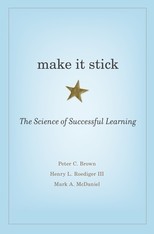Recently, UP’s College of Arts & Sciences held its annual book-club reading of a work on pedagogy. This year’s title was Make it Stick: the Science of Successful Learning (P. Brown/H. Roediger/M. McDaniel, 2014), and Jeffrey White led faculty in a discussion.
If you were among the participants, did the book’s methods “to learn better and remember longer” actually stick?
Whether you are new to the book or not, here’s a quick overview of a few of its lessons for the classroom.

Make it Stick was published the same year (2014) as Benedict Carey’s How We Learn. It contains similarly counterintuitive lessons that were derived from research in the cognitive psychology of learning (my two-page overview of that book can be found here).
The book’s epigraph comes from Aeschylus: “Memory is the mother of all wisdom.” Make it Stick insists that human learning primarily originates not through new information but through remembering what you have already encountered. (For so often, it takes this kind of reflection to recognize – often for the first time – the value your experiences hold.)
The authors point to data showing how our classic learning strategies of cramming, underlining, highlighting, and repetition simply do not have long-term value for remembering.
They would have us replace these ineffective methods with tools that actually work: ones that are more effective in disrupting the natural process of forgetting. So, for our purposes of teaching at UP here are six challenges drawn from the book:
How might you integrate “interleaving” into your curriculum? As the book explains interleaving involves practicing different topics or skills in a series – rather than focusing long and hard on just one. Learning at different times, in different spaces, and with different subjects helps multiply “retrieval cues,” fostering better access to our memories.
How might you integrate forgetting into your curriculum? Students should remember to forget in order to exercise the muscles of retrieval. Make it Stick suggests we honor the fact that “learning is an iterative process that requires you to revisit what you have learned earlier and continually update it and connect it with new knowledge” (21-2). While “the amount of study time is no measure of mastery” (10), a more dependable criterion for mastery involves the number of times you forget and then remember a topic or skill. Time and interleaving can foster the crucial practice of forgetting. (They suggest, for example, deliberately employing days between classes to forget, so that we then start our classes by having students try to remember what was covered in the last meeting.)
How might you add more quizzes to your course? The book champions an increased number of low-stakes quizzes across the semester, to help foster the practice of self-quizzing. This simple activity gives students a more accurate understanding of how much they know and don’t know (for overconfidence in what one knows is all too common). And it helps interrupt forgetting.
How might you integrate the habit of “writing to learn” into your course? A regular habit of low-stakes, informal writing in your class (journal entries, freewrites, targeted reflections) provides cognitive variety in a lecture-based class, and fosters personal connections necessary to unite students with new concepts. By thinking on paper, students are practicing “retrieval, elaboration, and generation” – internal activities that no lecture can provide.
How might you integrate the “concrete and personal” into your curriculum? We remember things best when they matter to us. Make it Stick urges that instructors not be shy about weaving personal anecdotes into the content of their lessons: “Learning is stronger when it matters, when the abstract is made concrete and personal” (11). While it might seem self-indulgent to bring yourself into the picture, serving as a model to students of how to integrate a subject into our everyday lives helps clarify the stakes involved.
How might you make learning more difficult in your class? This wildly counterintuitive strategy suggests we stop streamlining our curriculum for ease – for the best, most long-lasting learning happens when the learning is hard. Students do better when we give them the room to struggle with difficulty. Forms of such “desirable difficulty” include adding to your class more puzzles, problems, and riddles than you currently do: “It’s better to solve a problem than to memorize a solution” (88). So if we truly want to learn (and remember) a concept, we should turn off that pleasurable TED talk, and reach instead for the textbook.
(In other words, stop reading featherweight, short-form reviews like this one, and crack open Make it Stick!)
-Lars Erik Larson, UP English Dept, 2018

Thanks for your fine post, Lars. I’m glad to see that you find Brown, Roediger, and McDaniel’s ideas helpful. I was in a meeting with a group of students on Thursday to prepare for a Founders’ Day panel, and one noted that her history professor mentioned our workshop and has been incorporating some of the principles from Make it Stick in her class.